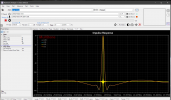Keith_W
Major Contributor
Can you expand on what you specifically mean here? Time alignment between the drivers needs to be repeated? Can you describe exactly what filters you are applying?
LR4 HPF @ 50Hz, and LR4 LPF @ 50Hz.
With reference to the above diagram, red is the LPF, green is the HPF, and brown is the sum of LPF + HPF. I have placed a marker at 50Hz.
At 50Hz, the phase of the LPF is -179 deg. The HPF is -158 deg. I have to align both to the tweeter, which itself is rotating phase. To avoid confusing matters, let's say it is at 0 degrees.
Phase = time. We can calculate the time discrepancy from the phase angle with t = theta / (360*f). So the LPF is 179/(360*50) = 9.94ms, and the HPF is 8.78ms.
In reality the drivers themselves introduce additional phase rotation, and as mentioned the tweeter probably isn't at 0 degrees. This is why the time alignment procedure needs to be repeated. Regardless, I always repeat the time alignment procedure whenever I make a change to the XO if there are phase changes (there are always phase changes). It's just good practice.


